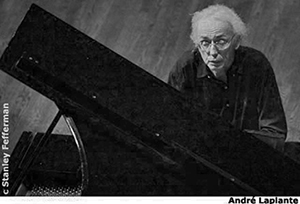 July 24, 2013. Walter Hall, Toronto.
July 24, 2013. Walter Hall, Toronto.
Haydn: Piano Sonata No. 52 in E flat Major. André Laplante jumped into it with gusto and delicate musicality. Arpeggios and trills rolled by at speed but crisply. Laplante marshalled their flow into a palpable sonata structure. His deliberation in suspending the flood of ideas during ruminative passages produced a limpid, tranquil effect that mastered the audience.
This is late Haydn, inspired by his contact with sophisticated London audiences of the 1790’s, the powerful sonorities of a new English-designed piano, and the formidable abilities of virtuosa Thérèse Jansen. Laplante brought out the subtle shapes of Haydn’s explorations in the tender opening part of the Adagio with pedalling that beautifully balanced sustained and dampened effects. In the later sections of dark, passionate, insistent passagework, Laplante developed a gnarly texture that subsides into a tolling at the end. He took the Rondo finale at a blistering pace, but with such perfect articulation that I had to remind myself to breathe.
Saint-Saëns: Sonata for clarinet and piano, Op. 167. In the last year of his life, at the age of 85, Camille Saint-Saëns wrote to a friend, “I am using my last energies to add to the repertoire for [this] otherwise neglected instrument….” Yao Guang Zhai, second chair at the TSO joined Laplante to correct this neglect. Their collaboration had many fine moments but not much magic until the fourth movement where the Saint-Saën’s virtuoso writing justified Mr. Zhai’s tendency towards colouring more brightly than the piano. The music they made together in the quiet, lyrical closing that glanced back to the Sonata’s beginning was magical and deserved the bravos and ovations.
Jean Françaix: Woodwind Quintet No. 1. Tremendous colour and a riot of textures here in what bassoonist Nadina Mackie Jackson introduced, quite rightly, as a roller-coaster ride. A quick first impression of the music is that it is like a musically elegantized gabble of barnyard voices, the highly stylized rumble and hoot of downtown traffic, sounds not lyric but satiric, raucus as a cabaret, sardonic as a bauhaus opera, outrageous as a cartoon, or a lampoon, mostly anti-sentimental but sometimes, as in the third movement, full of a floating, flowing, heart-breaking pastoralism, and a fanciful exoticism we are familiar with from Poulenc and Stravinsky, composers that Françaix admired. In sum, a happy and welcomed excursion into the land of Cuckoo.
Mozart: Quintet in E-flat major for Piano and Winds, K. 452. The opening this 1784 work Mozart called “The best work I have ever written…” shows the winds as partners to the piano: each wind is given a brief run at the theme, and then are allowed to converse in pairs and other combinations among themselves and with the piano. The playing of the ensemble at this point was so extraordinary that sometimes Laplante’s piano sounded like a wind. The second movement, introduced by bassoon and oboe in concert with piano was perfectly sweet and mellow in a way that developed in the following year into the “Elvira Madigan” theme of Mozart’s 21st Piano Concerto. All five instruments shared the unique cadenza in the concluding Rondo, before it danced, sparkling, over the edge of its time, and dissolved into an energized audience.
André Laplante’s guests were: Leslie Newman, flute; Sarah Jeffrey, oboe; Yao Guang Zhai, clarinet; Nadina Mackie Jackson, bassoon; Gabriel Radford, French horn.
